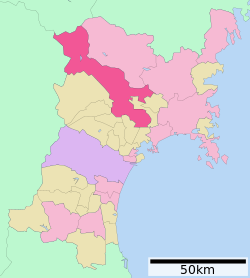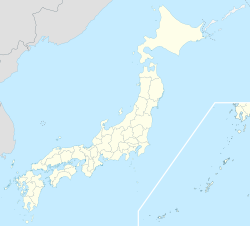
Date is a city in Iburi Subprefecture, Hokkaido, Japan. Date was established around 1869, and became a city on April 1, 1972.

Yuzawa is a city located in Akita Prefecture, Japan. As of 31 January 2023, the city had an estimated population of 41,404 in 17551 households and a population density of 52 persons per km2. The total area of the city is 790.91 km2 (305.37 sq mi). Yuzawa claims to be the birthplace of the famous Heian period poet Ono no Komachi.

Kazuno is a city located in Akita Prefecture, Japan. As of 28 March 2023, the city had an estimated population of 28,329 in 12,570 households, and a population density of 40 persons per km2. The total area of the city is 707.52 square kilometres.

Obanazawa is a city located in Yamagata Prefecture, Japan. As of 1 February 2020, the city had an estimated population of 15,237, and a population density of 40.9 persons per km2. The total area of the city is 372.32 square kilometres (144 sq mi).

Takayama is a city located in Gifu Prefecture, Japan. As of 1 January 2019, the city had an estimated population of 88,473 in 35,644 households, and a population density of 41 persons per km2. The total area of the city was 2,177.61 square kilometers (840.78 sq mi) making it the largest city by area in Japan. The high altitude and separation from other areas of Japan kept the area fairly isolated, allowing Takayama to develop its own culture over about a 300-year period.

Tanabe is a city located in Wakayama Prefecture, Japan. As of 1 November 2021, the city had an estimated population of 70,972 in 35,076 households and a population density of 69 persons per km2. The total area of the city is 1,026.91 square kilometres (396.49 sq mi). Tanabe is the second most populous city in Wakayama, and the largest in the Kansai region of Japan in terms of area.

Masuda is a city located in Shimane Prefecture, Japan. As of 31 July 2023, the city had an estimated population of 43,885 in 21249 households and a population density of 60 persons per km2. The total area of the city is 733.19 square kilometres (283.09 sq mi).

Saiki is a city located in Ōita Prefecture, Japan. As of 31 October 2023, the city had an estimated population of 65,870 in 32921 households, and a population density of 73 persons per km2. The total area of the city is 903.11 km2 (348.69 sq mi), making it the largest city by area in Kyushu.

Tsushima is an island city grouped in Nagasaki Prefecture, Japan. It is the only city of Tsushima Subprefecture and it encompasses all of Tsushima Island, which lies in the Tsushima Strait north of Nagasaki on the western side of Kyushu, the southernmost mainland island of Japan. As of March 2017, the city has an estimated population of 31,550 and a population density of 45 persons per km2. Its total area is 708.61 km2, 17.3% of the area of Nagasaki Prefecture.

Gero is a city located in Japan's Gifu Prefecture. As of 31 October 2017, the city had an estimated population of 33,283, and a population density of 39 persons per km2, in 12,253 households. The total area of the city was 851.21 square kilometres (328.65 sq mi). The city is famous for its hot springs.

Sakai is a city located in Fukui Prefecture, Japan. As of 10 May 2018, the city had an estimated population of 92,210 in 31,509 households and a population density of 550 persons per km2. The total area of the city was 209.67 square kilometres (80.95 sq mi).
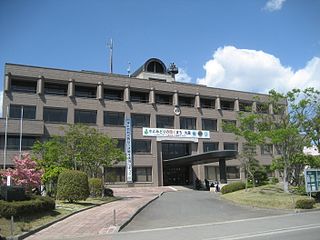
Marumori is a town located in Miyagi Prefecture, Japan. As of 1 June 2020, the town had an estimated population of 13,092, and a population density of 48 persons per km2 in 5,050 households. The total area of the town is 273.30 square kilometres (105.52 sq mi).

Watari is a town located in Miyagi Prefecture, Japan. As of 31 March 2020, the town had an estimated population of 33,459, and a population density of 450 persons per km2 in 12,643 households. The total area of the town is 73.60 square kilometres (28.42 sq mi).

Ōhira is a village located in Miyagi Prefecture, Japan. As of 31 May 2020, the village had an estimated population of 5,918, and a population density of 98 persons per km2 in 2108 households. The total area of the village is 60.32 square kilometres (23.29 sq mi).

Kurihara is a city located in Miyagi Prefecture, Japan. As of 30 April 2020, the city had an estimated population of 66,565, and a population density of 83 persons per km2 in 24,994 households. The total area of the city is 804.97 square kilometres (310.80 sq mi). Parts of the city are within the borders of the Kurikoma Quasi-National Park.

Kitaakita is a city located in Akita Prefecture, Japan. As of 28 February 2023, the city had an estimated population of 29,201, and a population density of 120 persons per km2. and a population density of 25 persons per km2. The total area of the city is 1,152.76 square kilometres (445.08 sq mi).

Minamiaizu is a town located in Fukushima Prefecture, Japan. As of 1 April 2020, the town had an estimated population of 15,158 in 6,575 households, and a population density of 17 persons per km2. The total area of the town was 886.52 square kilometres (342.29 sq mi).
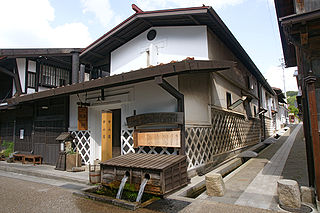
Kiso is a town located in Nagano Prefecture, Japan. As of 5 April 2019, the town had an estimated population of 11,045 in 4892 households, and a population density of 23 persons per km2. The total area of the town is 476.03 square kilometres (183.80 sq mi). Kiso Town is listed as one of The Most Beautiful Villages in Japan.
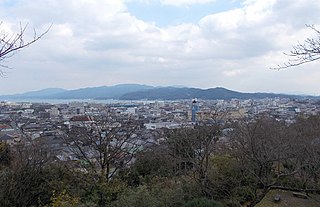
Amakusa is a city located in Kumamoto Prefecture, Japan. As of 31 August 2024, the city had an estimated population of 72,243 in 36029 households, and a population density of 110 persons per km2. The total area of the city is 683.82 km2 (264.02 sq mi).

Shibushi is a city located in Kagoshima Prefecture, Japan. As of 30 April 2024, the city had an estimated population of 28,889 in 15135 households, and a population density of 100 persons per km². The total area of the city is 290.21 km2 (112.05 sq mi).

